Healthcare branding is the strategic process of creating a distinct identity that builds patient trust, loyalty, and preference for your medical practice. Unlike generic marketing tactics, healthcare branding focuses on long-term relationship building through consistent messaging, visual identity, and patient experiences.
Key Healthcare Branding Elements:
The stakes are high. Research shows 75% of patients research providers online before booking appointments, while 60% consider care and compassion essential when choosing healthcare providers. Most telling: 80% of patients won't return after a negative experience.
With the healthcare market projected to reach $1.5 trillion by 2032, competition is fierce. Generic marketing simply doesn't cut through the noise anymore. Healthcare practices need strategic branding that speaks directly to patient fears, hopes, and decision-making processes.
As Grace Ascione, a registered nurse with an MBA and 15+ years of healthcare marketing experience, I've helped countless small healthcare businesses transform their patient acquisition through strategic healthcare branding that combines clinical insight with proven marketing principles.
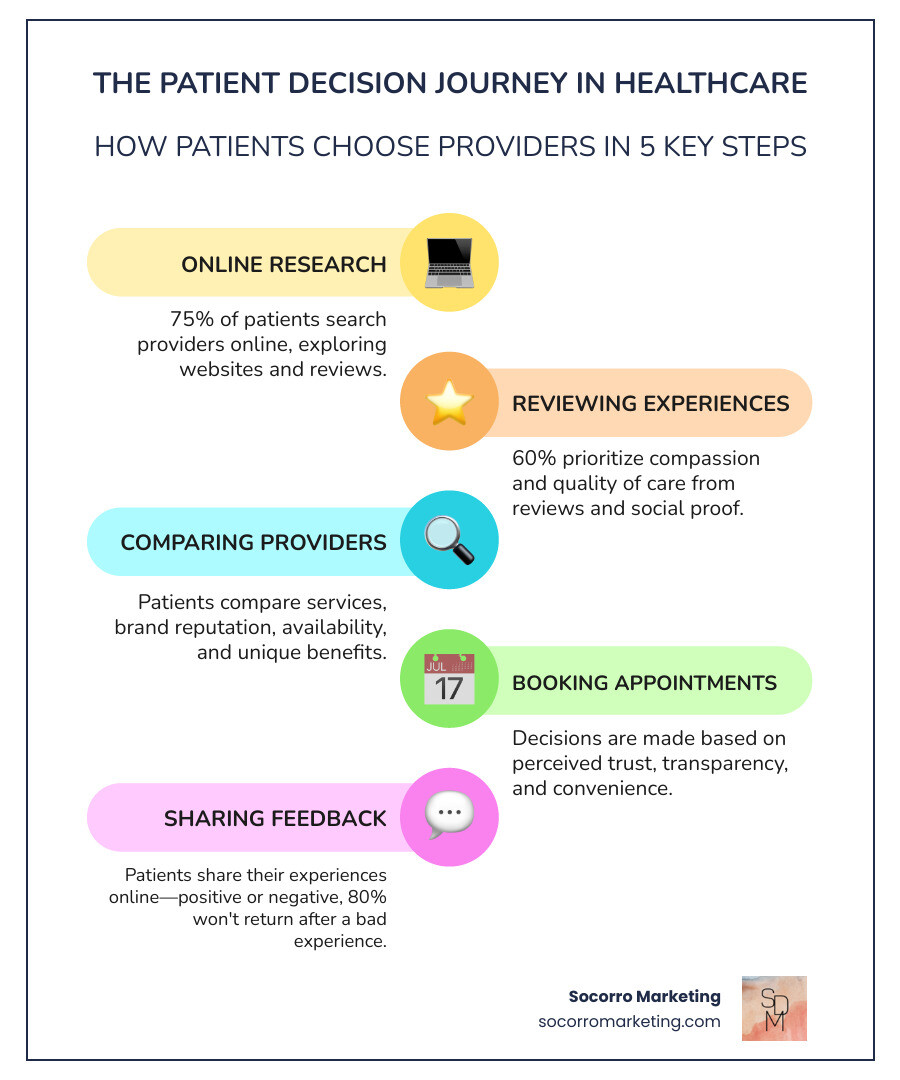
Most healthcare providers mix up branding and marketing, and it's costing them patients. Healthcare branding is like building your house's foundation—it's your mission, values, and how patients feel when they think about your care. Branding answers: "What makes our practice special?"
Healthcare marketing is like putting up "Open House" signs—the Google ads, social media posts, and events that get immediate attention. Marketing says, "Hey, we're here and we can help you today."
Your brand is your reputation; marketing is how you spread the word. A patient might find you through a Facebook ad (marketing), but they'll choose you because they heard you really listen (branding).
| Healthcare Branding | Healthcare Marketing |
|---|---|
| Strategic foundation | Tactical execution |
| Long-term relationship building | Short-term patient acquisition |
| Emotional connection | Rational persuasion |
| Brand promise and values | Specific services and offers |
| Builds trust and loyalty | Drives immediate action |
The practices that thrive understand both are essential. Your brand gives meaning to your marketing, and your marketing gives your brand a voice.
When healthcare providers think "marketing," they often feel uncomfortable—like they're being pushy. But when you think "branding," something shifts. You're not selling—you're sharing who you are and why you care.
Consistent messaging across every patient touchpoint creates the "comfort factor." When patients see the same caring approach on your website, hear it in your staff's voice, and feel it during their visit, they relax and trust what to expect.
This consistency transforms your team too. When everyone understands they're representing your brand promise, they become more engaged. Your receptionist isn't just scheduling—she's being the welcoming face of your practice.
Trust isn't just important in healthcare—it's everything. When patients choose your practice, they're placing their health and fears in your hands. Healthcare branding goes far beyond logos and slogans.
Research shows 36% of patients have skipped care because of negative experiences with providers. This isn't always about medical mistakes—often it's about feeling rushed, unheard, or treated like a number.
Strong healthcare branding addresses trust barriers head-on. When patients feel genuinely cared for, they become your biggest advocates, telling friends and family about their amazing experience.
Healthcare trust rests on four pillars: Transparency means explaining procedures and costs clearly. Consistency builds confidence—patients know they'll receive the same caring attention every visit. Compassion separates good providers from great ones—patients remember how you made them feel. Competence completes the equation—patients need to believe you can help them.
According to healthcare marketing statistics, practices with strong branding see dramatically higher patient retention and referral rates.
Healthcare decisions tap into our deepest emotions. Patients aren't just comparing services—they're looking for someone to protect them when vulnerable. This makes healthcare different from other industries.
Social Cognitive Theory explains how patients make decisions. They watch how others are treated, listen to stories, read reviews, and observe staff interactions. When patients see others having positive experiences through testimonials or recommendations, they feel safer choosing your practice.
Building strong healthcare brands requires navigating HIPAA compliance, especially around patient privacy and marketing claims.
Smart healthcare branding focuses on your process rather than specific outcomes. Instead of "We cured John's back pain," share "Our comprehensive approach includes thorough evaluation, personalized treatment plans, and ongoing support."
HIPAA violations carry serious consequences—fines range from $100 to $50,000 per violation. Beyond financial penalties, violations destroy the trust healthcare brands work hard to build.
Your healthcare branding is like a symphony where every instrument must play in harmony. Patients experience your brand through dozens of touchpoints that either build trust or create doubt.
Your mission and vision form the foundation. The best healthcare missions are simple and patient-focused. Instead of "providing quality healthcare services," try "helping families feel confident about their health decisions."
Visual identity needs to balance "I trust this practice" with "I want to spend time here." Your logo, colors, and design must feel professional yet welcoming.
Tone of voice might be the most overlooked element. Are you talking to patients or with them? Your voice should feel like the best doctor you've had: knowledgeable but not condescending, caring but not overly casual.
Service design is where your brand promise meets reality. Every process reinforces or undermines your brand. Practices that excel obsess over details because a patient's impression is shaped more by the wait time than your beautiful website.
Employee ambassadorship happens when staff genuinely believe in your mission and naturally communicate your values. This starts with hiring people who align with your mission.
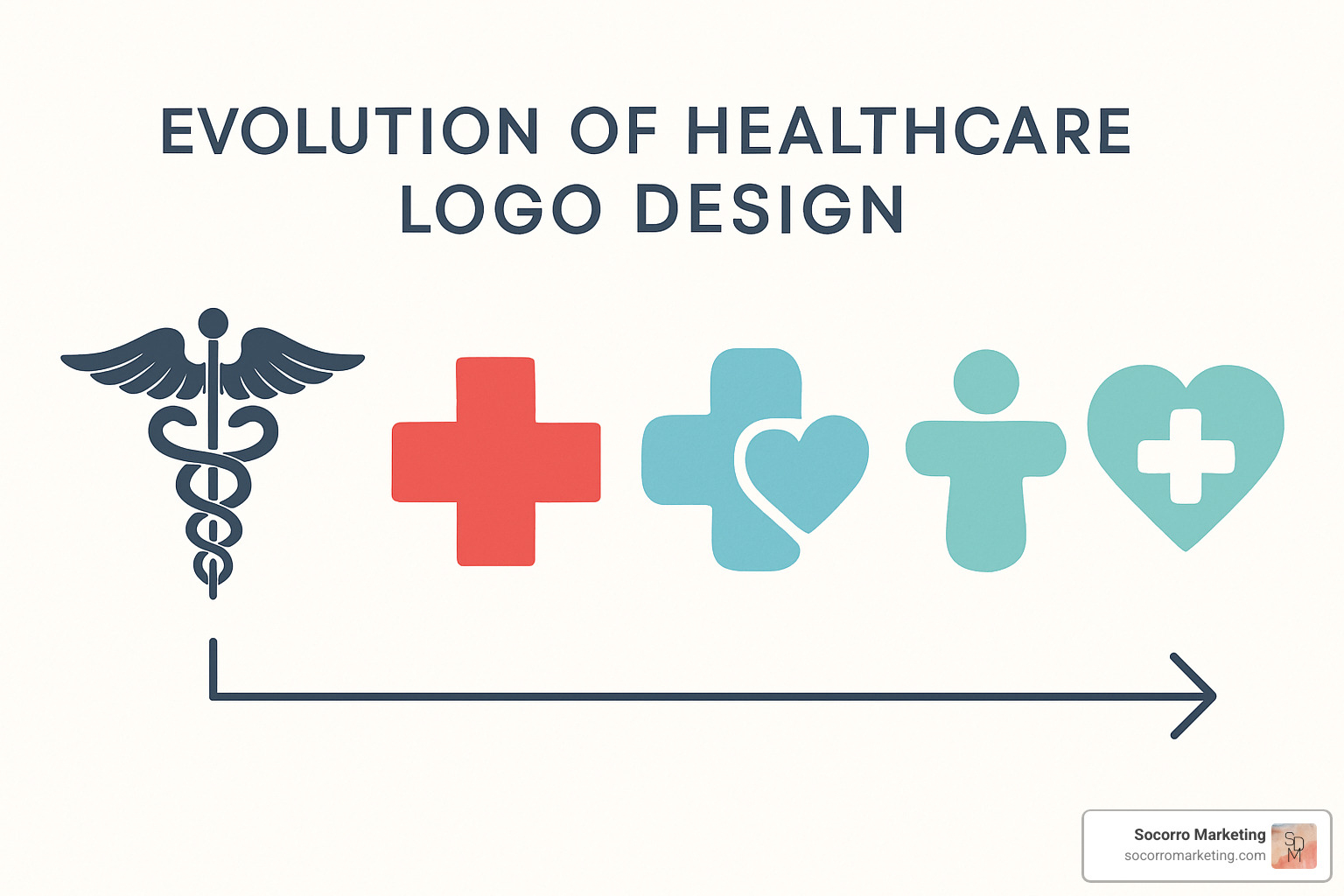
Your visual identity works 24/7. Choose fonts your 85-year-old patients can read as easily as 25-year-olds. Sans-serif fonts work well digitally, while serif fonts add credibility to print materials.
Color psychology is real, but don't feel trapped by medical clich9s. What matters is that colors feel right for your patient population. Ensure sufficient contrast for accessibility and readability across devices.
Most practices think branding is about what they want to say rather than what patients need to hear. Patient feedback bridges your brand intentions with patient reality.
Regular surveys and reviews give you data, but real insights come from understanding the stories behind numbers. The most valuable feedback often comes from patients who didn't returnthese exit interviews reveal brand gaps satisfied patients never mention.
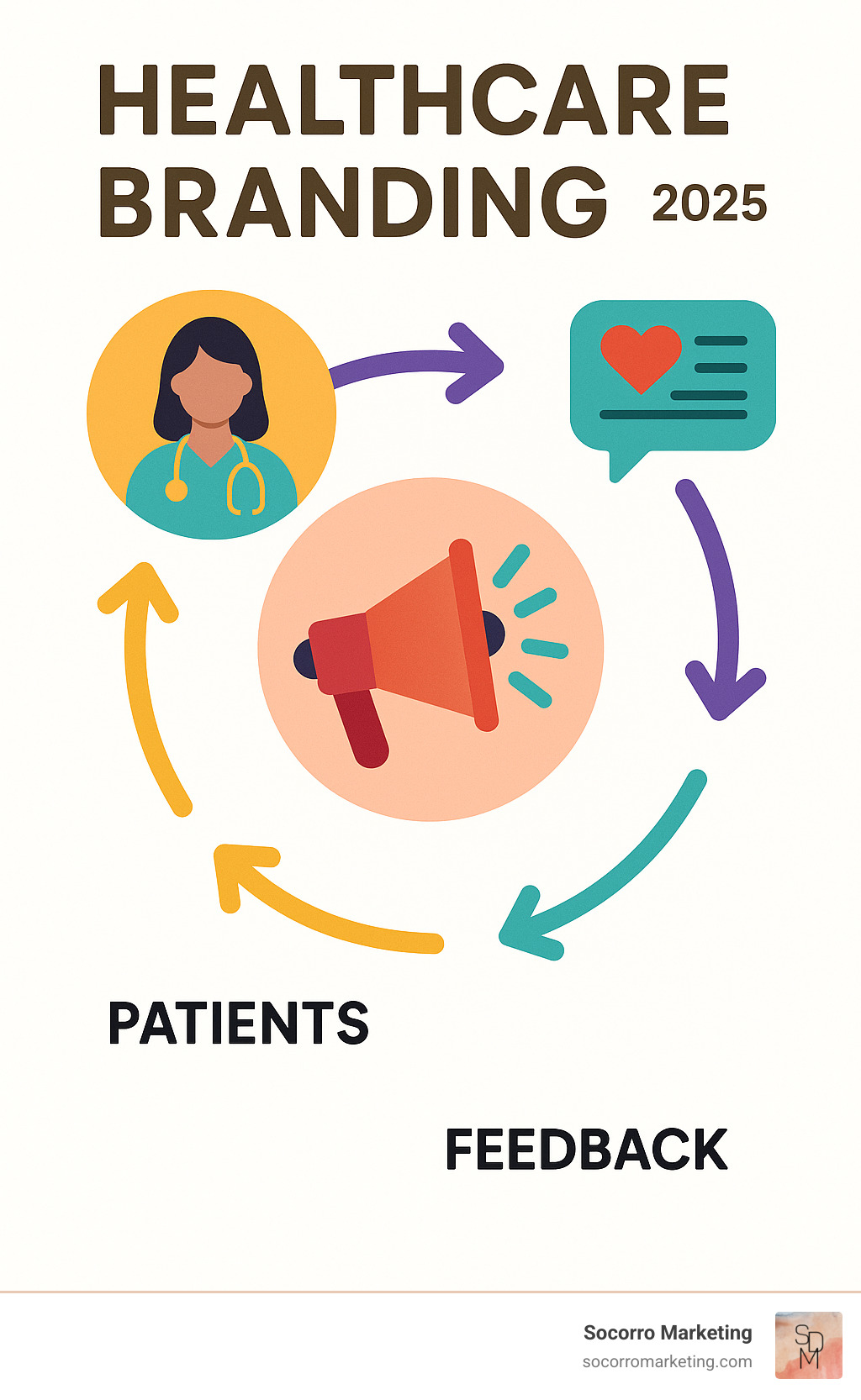
Creating powerful healthcare branding requires a systematic four-phase approach. After helping dozens of practices transform patient relationships, I've developed a proven process from brand confusion to market leadership.
Research forms the backbone. You need to understand your market landscape, patient motivations, and competitive positioning before making creative decisions. Audience segmentation is now used by 56% of healthcare branding campaigns—it's essential for creating resonant messages.
Persona mapping develops detailed profiles of ideal patients, including fears, hopes, and decision-making processes. Your unique value proposition makes patients choose you over competitors, going beyond clinical services to include experience factors and emotional benefits.
Competitive gap analysis reveals differentiation opportunities. An omnichannel strategy ensures consistent brand experience across all touchpoints. Storytelling framework development creates compelling narratives that connect emotionally.
Finally, establish KPIs and measurement systems to track brand performance over time.
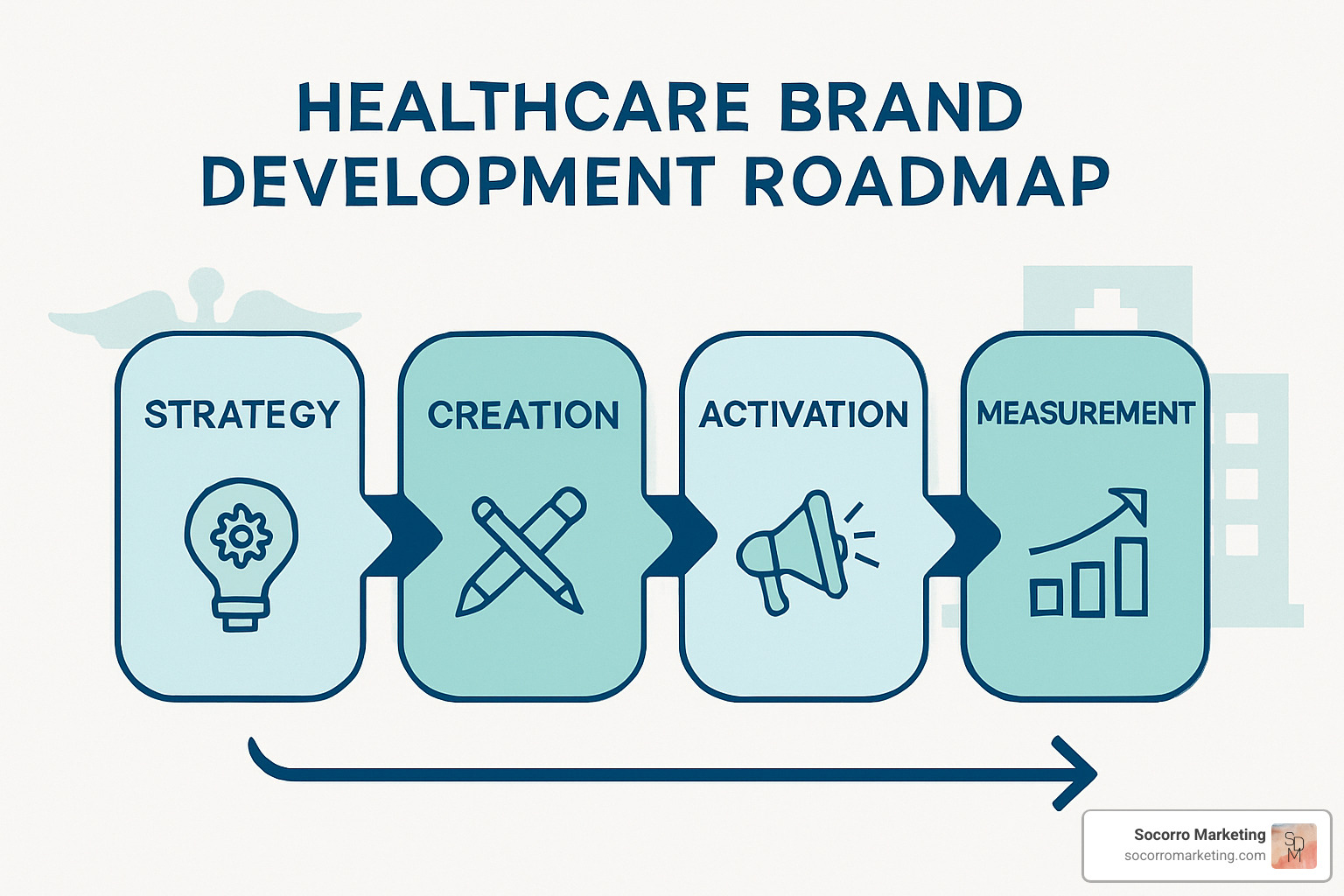
SWOT analysis provides the big picture of strengths, weaknesses, opportunities, and threats. Stakeholder interviews with patients, staff, and leadership reveal gaps between what you think you deliver and what patients actually experience.
Touchpoint analysis examines every patient interaction, mapping the entire journey to identify where your brand shines or falls short.
Tagline development distills your unique value into memorable phrases. Your narrative framework guides all communications, addressing key patient questions about why they should choose you.
Visual toolkit creation balances clinical credibility with human warmth, developing comprehensive guidelines for consistency.
Staff training helps your team understand the brand promise and their role in delivering it. Brand guardians champion the brand daily. Patient onboarding redesign ensures new patients experience your brand from first interaction.
Analytics tracking shows which touchpoints work. Sentiment tracking provides real-time brand perception feedback. Iterative testing ensures continuous improvement as your brand evolves with patient needs.
Healthcare is changing rapidly, and your brand must keep up. The pandemic transformed patient expectations completely.
Telehealth went from nice-to-have to essential. Your healthcare branding needs to work through computer screens as well as in person. Personalization is the new standard—patients want providers who remember preferences and communicate meaningfully.
Voice search is revolutionizing how patients find providers. AR and VR technologies help patients understand procedures and feel comfortable with treatments. Sustainability and diversity, equity, and inclusion are values patients genuinely care about.

75% of patients use search engines before booking appointments. If your brand isn't showing up, you're invisible to three-quarters of potential patients.
Digital marketing statistics show practices with strong online brands consistently outperform those relying on outdated methods.
Local SEO is crucial—most patients seek neighborhood providers. Paid mass media is part of 79% of healthcare branding campaigns, but works best when supported by genuine patient stories.
Patients are becoming healthcare consumers, expecting retailer-level service. Value-based care means focusing on outcomes and value created. Retail health expansion creates more competition but also opportunities for adaptable brands. Home-based care means your brand experience must extend beyond office doors.
Healthcare branding is like planting a tree. You'll see green shoots within 3-6 months, but real harvest comes after 12-18 months of consistent effort.
Early months bring increased website traffic, patient inquiries, and improved reviews. Big wins take longer: patient retention rates improve, referral rates increase, and you attract patients who choose you specifically for your brand values.
Timeline depends on your starting point. Established practices needing better positioning see faster results than those starting from scratch. Practices staying consistent with branding always outperform those who start and stop.
Absolutely yes—small practices often have huge advantages over large health systems. Effective healthcare branding isn't about budget size—it's about being strategic.
Small practices have superpowers: quick pivoting, genuine personal relationships, and clearer brand stories. Start with foundation work—clarify your unique value proposition before worrying about expensive advertising.
Sometimes the most powerful moves are free: training staff to answer phones warmly, following up personally with patients, or being more consistent in communications.
Patient retention rate is most important—if patients keep returning and bringing family, your brand works. Net Promoter Score reveals whether you create genuine advocates. Online review ratings give real-time brand perception feedback.
Referral rates from patients and physicians indicate brand strength. Website engagement metrics show if your brand story resonates. Brand awareness ties everything together—how many people know who you are and what you stand for.
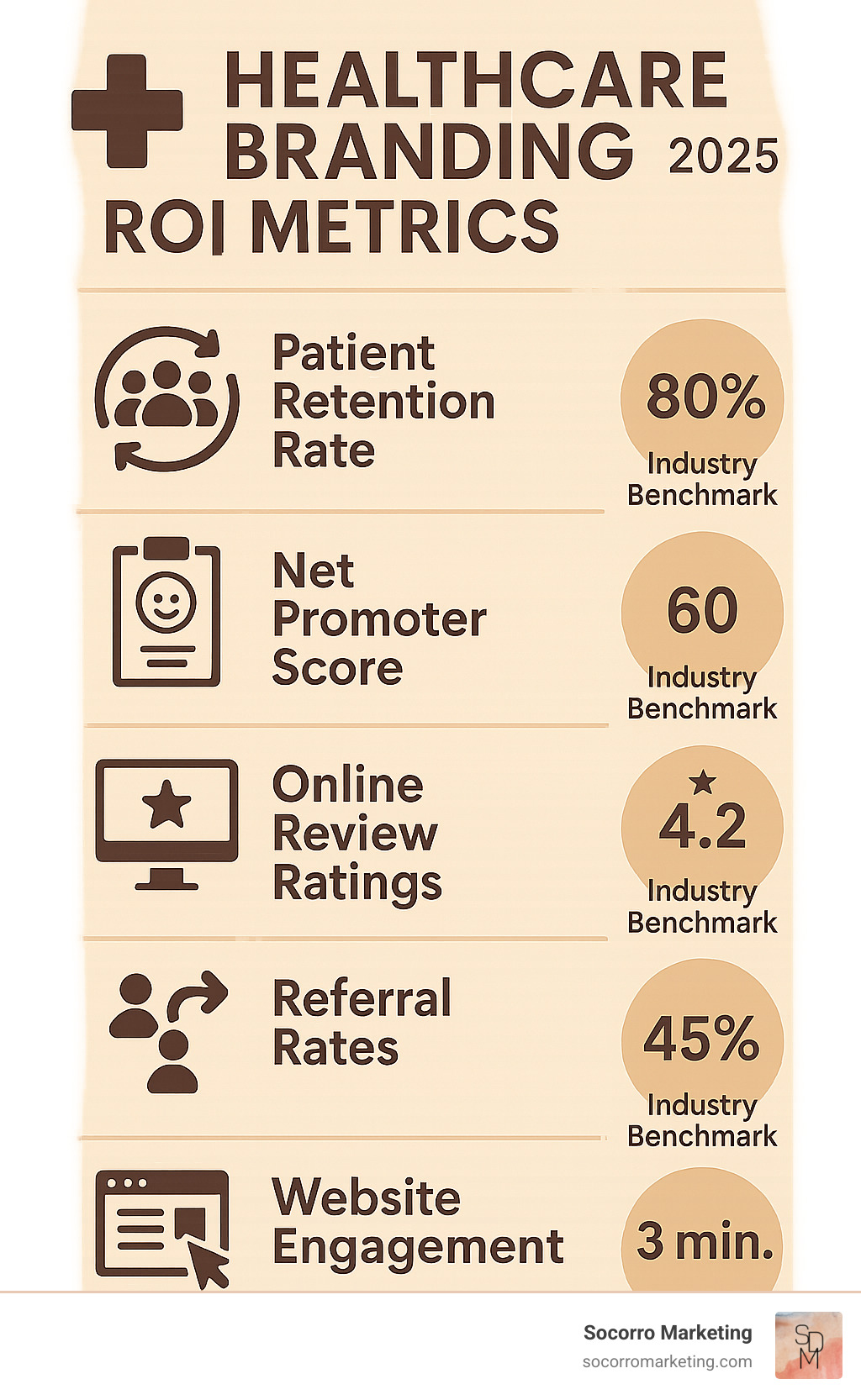
Healthcare branding isn't about pretty logos—it's about creating genuine connections that keep patients coming back. Patients choose providers based on trust, compassion, and complete experience. Clinical skills matter, but they're just the starting point.
Every patient interaction shapes your brand whether you manage it or not. That rushed phone call? That's your brand. Your waiting room atmosphere? That's your brand too.
At Socorro Marketing, we understand both sides—clinical realities and effective marketing strategies. Our nurse-managed approach means we know what it's like to care for patients while growing a practice.
Practices we work with see real results: better patient retention, more referrals, engaged staff, and the ability to charge what they're worth. When patients value your complete experience, they're not shopping for the cheapest option.
Your brand is forming right now with every review, conversation, and patient interaction. You can control that process or leave it to chance.
The healthcare landscape is changing fast. Being a good clinician isn't enough—you need to be meaningfully different in ways that matter to patients.
Ready to build a healthcare brand that truly connects? Learn more about our healthcare branding services and see how our clinical perspective can help you create something special.